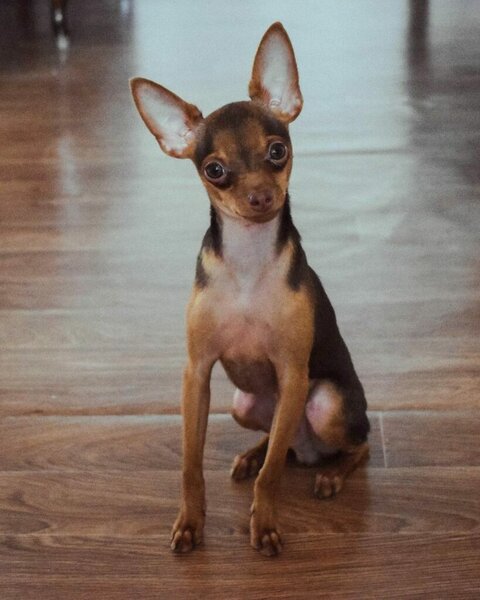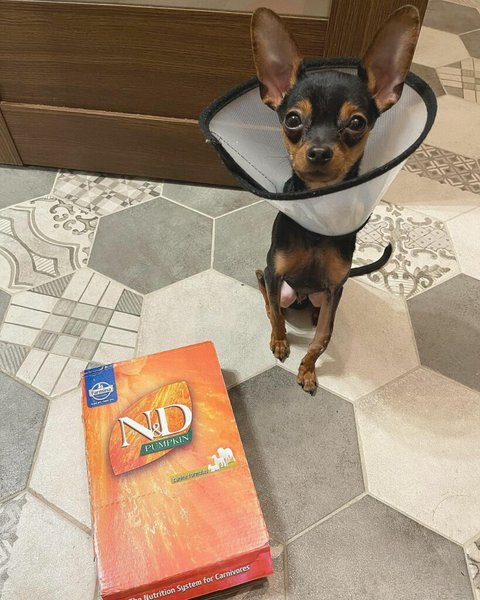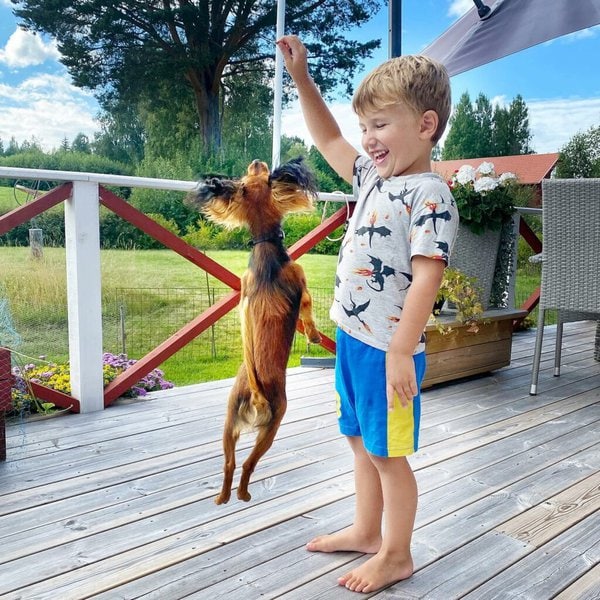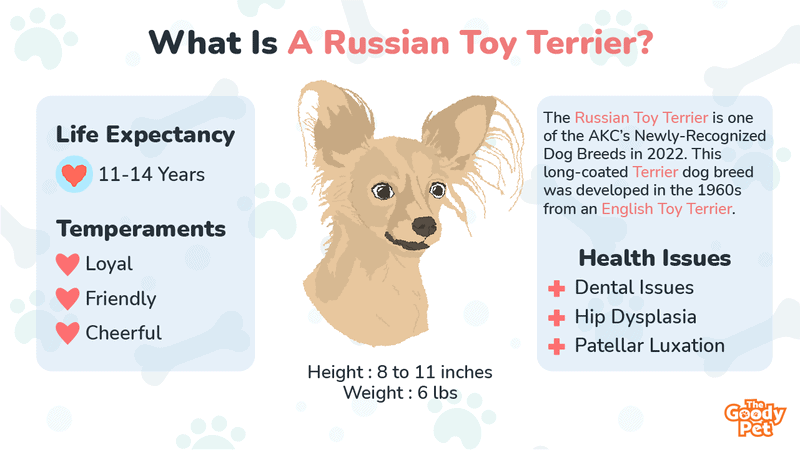Russian Toy Terriers make great pets. If you recently bought one or are in the market for one, you should learn a thing or two about your furry friend. For one, they’re clingy with their owners but a bit stiff with strangers.
Previously known as the Moscow Long-Haired Toy Terrier, or simply Russkiy Toy, the Russian Toy Terrier is one of the AKC’s Newly-Recognized Dog Breeds in 2022. This long-coated Terrier dog breed was developed in the 1960s from an English Toy Terrier. The result was a small yet sturdy dog with many desirable qualities inherited from its parents.
These charming little dogs are very affectionate and loyal to their owners. They are rare, with an estimated population size of 775 in the US in 2022. This guide explains the details about the Russian Toy Terrier, so you can care for and bond better with your pet companion. But first, let’s clear up a common misconception about the Russian Toy and the Chihuahua.
Is Russian Toy Smaller Than Chihuahua?

Although both of them are small dog breeds, the Russian Toy is deemed to be smaller than the Chihuahua.
Chihuahuas look like Russian Toy Terriers because of their size, but they have a few distinct differences. Upon gaining official recognition by the AKC, Russian Toys will gain popularity in the coming years, and you’ll get to see more of them. Therefore, it is important to know how to tell them apart.
How Big Do Russian Toys Get?
Your Russian Toy Terrier puppy will grow into a small adult dog 8 to 11 inches tall and weigh about 6 lbs. Female dogs are slightly smaller than male dogs, with males growing up to 11 inches tall at the shoulder and females growing up to 10 inches tall at the shoulder.
Is A Russian Toy A Chihuahua?
No, the Russian Toy is not a Chihuahua.
People often mistake the Russian Toy for Chihuahuas because of their similar features. They both come in long-haired varieties. Plus, they were both developed in the 19th century. But the Russian Toy originated in Russia, while Chihuahuas originated in Mexico.
Physical Appearance
The head shape of both breeds is also very similar, with both having triangular heads. Nonetheless, Chihuahuas have apple-shaped heads, while Russian Toys have narrower heads.
The nose of each species is pretty short and broad with large nostrils, but Russian Toys have a longer muzzle. Another distinct feature of this dog breed is the big triangular ears set high on its heads and erected, pointing straight to the sky.
Russian Toys have more delicate bones than Chihuahuas. If a Russian Toy were to jump off your couch onto the floor, it could fracture a limb.
Coat Colors And Patterns
Russian Toy dogs’ coat colors include blue and tan, brown and tan, red, sable, brown sable, and black and tan, with black being the most common.
The Russian Toy has two varieties, namely smooth-coated and long-coated ones. The long-coated Terrier was previously called the “Moscow Long-haired Toy Terrier,” but in 1988, the smooth-coated Russian Toy and Moscow Long-haired Toy Terrier received the name “Russian Toy Terrier.”
How Long Do Russian Toys Live?

Russian Toys have a lifespan of 11 to 12 years, but some have lived longer. For a small dog, that lifespan is considered to be long. A lifespan of 14 years is possible if you care for your Russian Toy consistently.
Dogs that are well cared for, fed a good diet, and exercised regularly can be expected to live longer than the typical span of their breed.
Your canine’s lifespan depends on genetics, diet, and living conditions. Some breeds are naturally more prone to certain diseases than others. This breed is a very clever, energetic, and agile dog that adapts quickly to various living conditions.
Russian Terriers are a very healthy breed, but they can develop some common health issues. A list of common health problems follows:
Dysplasia
Dysplasia occurs when the leg or shoulder bone does not grow in tandem with the hip socket, causing a misalignment that leads to discomfort in maturing Russian Terriers. Over time, if the hip joint still doesn’t fit properly into the socket, it can lead to lameness and pain in this dog breed.
Patellar Luxation
Patellar luxation is a genetic disease where the dog’s kneecap dislocates. You will have to visit a vet for correction, which in severe cases involves surgery.
Progressive Retinal Atrophy
PRA is a genetic disorder that occurs when photoreceptors (rods and cones) at the back of the eye deteriorate, leading to vision loss.
Dental Issues
Their deciduous (puppy) teeth may refuse to fall out, stopping the growth of adult teeth. Visit a vet to remove puppy teeth.
How Do You Take Care Of A Russian Toy Terrier?
Russian Terriers are very active, so you have to make sure they exercise frequently. They love to go for walks, run around in the yard, or play fetch. The Russian Terrier is also very clingy to its owner, so you’ll spend a lot of time keeping your canine friend company.
Exercise Routine
Russian Toy Terriers are very energetic and active dogs. They need exercise to stay happy and healthy. You should take your dog out for at least one walk every day or play fetch daily. Exercising your pooch for 30 or 45 minutes every day is ideal.
High-Quality Diet
After weaning, you’ll have to adjust your pooch’s diet gradually, so it doesn’t affect their health. If your dog is a puppy aged 3 to 6 months, limit food to 3 to 4 meals daily. Two meals daily for an adult Russian Toy is ideal but shouldn’t exceed a cup of food, even for puppies.
The diet should contain 25% protein, fatty acids, and vitamins A, B, C, D, and E. Calcium should also be in the diet. You can check out Pet Plate for high-quality dog food. Keep in mind that whatever you feed your Russian Toy should meet the nutritional standards of the AAFCO.
Use Dental Water Additives
Dental health should be a priority when grooming your furry friend. Water additives contain enzymes like glucose oxidase, potassium sorbate, and potassium thiocyanate, which are suitable for dental health. Add water additives to your dog’s water twice daily for the best results.
Are Russian Toys Easy To Train? Temperaments Of Russkiy Toys
Russian Toys Terriers are very smart and reasonably easy to train. They are quick learners and obey commands, good or bad, so you must teach them from the puppy stage. They can adapt well to any environment if they have enough exercise.
Positive reinforcement works best because it encourages dogs to do what you have them do. Russian Toys are like babies; you’ll correct them with love. Keep training sessions short, i.e., no more than 10 minutes for puppies and 15 minutes for adults, so your dog doesn’t get bored or frustrated by the process.
Temperament
Russian Toy Terriers are cheerful, loyal, and territorial dog breeds. They have a very happy-go-lucky temperament and love to play all the time.
This breed is friendly toward children, but proper training and socialization are necessary to ensure they get along well with other dogs. They enjoy walking, running outside, and playing a game of fetch in the yard.
When choosing a Russian Toy Terrier for your family, consider how much time you can spend with your pet. These dogs need lots of attention from their owners, or they’ll suffer separation anxiety. If you work long hours or travel frequently, this might not be the right breed.

Are Russian Terriers Smart?
Russian Terriers are indeed smart. They are an intelligent dog breed with an excellent memory and learn quickly when appropriately trained. They’re also friendly and loyal to their owners.
When training your dog, remember that you will have to give plenty of praise after they do something right. This will help your pooch understand what he is doing right and encourage him to continue.
Do Russian Toy Dogs Shed? Grooming Tips For Russkiy Toys
Russian Toys shed but not very much. It is best to brush your long-haired dog daily with a soft-bristle brush like the FURminator undercoat tool. The smooth-coated Russian Terrier doesn’t shed much. So you won’t have to brush frequently.
Brushing your dog’s hair helps remove loose hair and tangles, resulting in a healthier coat. It also helps promote good blood circulation. Brushing your dog’s hair is one of the best ways to bond.
Dogs enjoy the attention and affection you show while grooming. Brushing also helps distribute natural oils throughout the fur, making the coat appear shiny and healthy and smell great!
Bathing is also necessary for many reasons, including keeping your furry friend’s skin healthy and preventing infections or irritation from flea bites.
How Can You Groom The Russian Toy?
The Russian Toy Terrier’s coat requires minimal maintenance:
- Bathe your doggie once every one or two weeks using a mild shampoo like Paws & Pals 6-in-1 oatmeal shampoo.
- Trim the hair around the anus and paw pads.
- Brush your dog’s teeth at least three times weekly to keep their breath fresh.
- Trim the nails with nail clippers regularly.
Are Russian Toys Hypoallergenic?
Russian Toy dogs are not considered hypoallergenic breeds. They do not shed much hair because of their short coat and lack of an undercoat layer. This means it is less likely to cause an allergic reaction in people allergic to dogs. The reason is that they do not produce dander.
Related Questions
How Much Do Russian Toy Terriers Cost? The average cost of the Russian Toy Terrier is $600 to $2,000. This price depends on factors such as the breeder and the location where you buy. A Russian Toy Terrier puppy is more expensive than an adult because they need special care, and it is difficult to find a breeder.
What Is The National Dog Of Russia? Much to our surprise, instead of the Russian Toy Terrier, the national dog of Russia is the Caucasian Shepherd. It was developed from dogs from the Caucasus Mountains and the steppe regions in the 19th century. They’re native to the Caucasus countries, such as Russia, Georgia, Armenia, and Azerbaijan, and were used as guard dogs and hunting dogs. Currently, they’re used as prison dogs in Russia.
What Is The Most Popular Russian Dog? The most popular Russian dog is the Siberian Husky, a sled dog breed. It belonged to the Spitz genetic family and was bred by the Chukchi people of Siberia in Russia. They were used for pulling sleds due to their active, energetic, and resilient nature but are now kept as pets.





